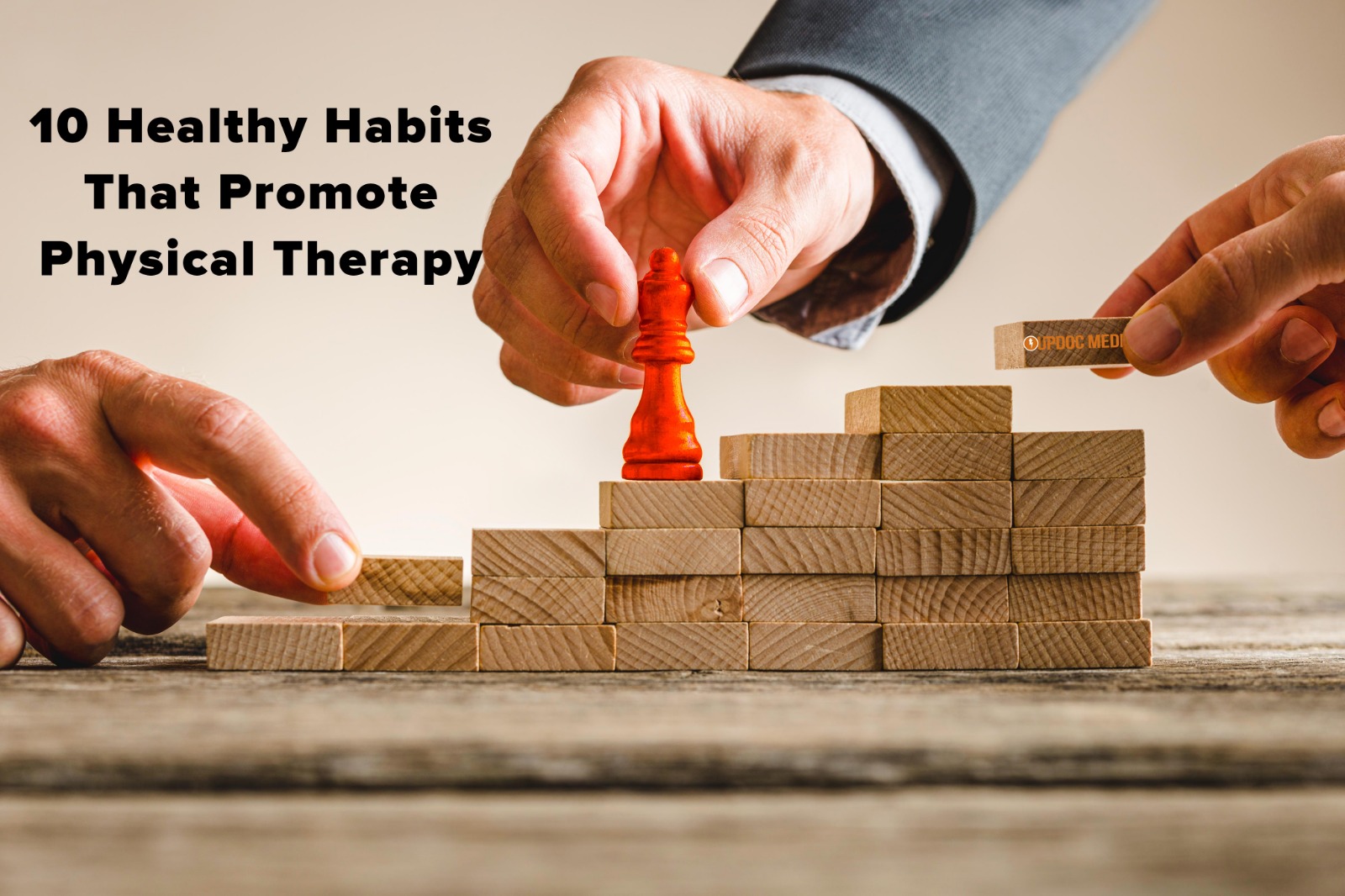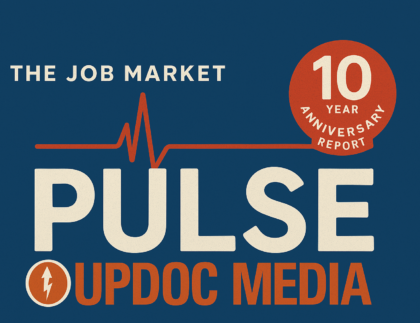
It’s the turn of a New Year and the decade of the 2020s. Around this time, many are looking to develop healthier habits, make resolutions, set goals, and dream big. The thing of it is, many times resolutions affect our personal lives; today’s theme is building habits that affect our professional lives as well.
AND, to move into our topic of the day — one of the biggest categories of resolutions out there is health.
So, without further ado… let’s dive right in to 10 healthy habits that promote physical therapy!
1. Share your #PTwins: Hero stories happen all the time.
Back at CSM 2017 in San Antonio, Texas — Rich Severin, Brett Kestenbaum, Greg Todd, and myself were part of a session that had the distinction of being the first physical therapy conference session to trend on Twitter.
Part of our challenge in this talk about transforming society through social media was for all physical therapy professionals to routinely share about their #PTwins. Physical Therapy wins is both a subject and a statement. We have daily wins ALL THE TIME. Wins that are reflected in our patients reaching their milestones and goals, as well as wins on personal and professional levels that can be uplifting to one another and to our stakeholders.
If you want to start off not just 2020 but this the 2020s as a decade in a strong foot forward in positivity, start with a commitment to sharing #PTwins across your social channels on a regular basis. It doesn’t have to be for the entire year, it doesn’t have to be every day or every week. How about just once a month? The first week of every month, share a meaningful story about how #PTwins — for the patient, for the community, for providers, for payers, for our society at large.
2. Invite family and friends to use you as a source of info.
Many of us probably experienced some form of this over the holidays when friends and family look to us for quick help and advice about health aliments. We already know too many people are under-served and under-attended in healthcare for things we can easily cover as the content experts in physical health.
Why not open ourselves up as a resource? Why not make it very well known that “you can come to us if you have questions or concerns?”
After all, with one of the highlighted concerns of our industry internally being lack of public awareness of what physical therapy is and what physical therapists can do for patients, why not just be available at the source to help change this perception?
This leads us to…….!
3. Set the example. Be the change!
It doesn’t mean you need to have a 6 pack, eat only raw foods, and engage in 30 minutes of mindful meditation at the top of your daily 5am hilltop run.
It just means, live in pursuit of best health in a way that would make you proud to be seen — because: You ARE Seen.
When was the last time you told someone you were a Physical Therapist or Physical Therapist Assistant… or, any of the allied rehab therapy professions…… and, the person you were talking to had absolutely no idea what you did, who you were… just a plain and blank stare??? The fact is, major media and the entertainment industry have keyed into the fact that rehab therapists make good television (see “PT on TV”). We’ve been in the limelight, and, we’ve been around long enough as an industry where people recognize us and know us.
Now, while the general population may or may not have a full depth understanding of what we do… how much do WE really know what other professions do? Maybe even within the small circle of allied rehab therapy as it is? How detailed do we really know a nursing curriculum, or what MDs or DOs learn in school and receive in clinical training? What can we meaningfully outline in depth to what an audiologist, dentist, optometrist, or any other medical professional does in their entirety?
The chances are, if we were to try and spin down another medical profession’s roles, responsibilities, training, scope, and top of license capabilities… we’d likely and very unintentionally sell them short….. only because, we aren’t them and we don’t know them as well as they know themselves.
SO! This brings us all back to the fact that if we wish to be more known and more visible, if we want the public to see us as a first in line, choice provider: We need to lead by example. We live a life becoming of our profession. We need to engage in a way that shows us as accessible professionals and connect-worthy-individuals. We need to talk about our profession all the time… which leads us to!
4. A Vegan and A CrossFitter Walk Into A Bar…
“I only know this because they told the entire bar within two minutes.”
Too soon? ?
The fact is.. you ooze this stuff. Everything you see, everything you say, everything you hear, and everything you do is encoded like PT much as Neo interacts with the matrix.

If you are sensing a theme, you’re absolutely spot on. What this fourth habit is really encouraging you to do is to truly talk and share about Physical Therapy beyond the #PTwins sharing, beyond being available… it’s challenging you to be outwardly expressive in the same way you’re already inwardly aware of how so many facets of life can be seen in PT code. So, share it and share it gratuitously. The 2020s as a decade could certainly use some social influence in pursuit of best health.
5. Lead a community class.
During the nascent years of my career, I had the opportunity to open up a hospital based community fitness/wellness program based on kettlebells and physical therapy wellness principles. During the two years we ran that program, we were named as finalists for the Best in San Diego contest as ran by the local news outlet The Union Tribune. Now, this was way back in the early twenty-teens.
That said, it was an incredible experience as it most fitness programs come out of gyms, studios, and health clubs — rarely do they come out of a medical brand or healthcare practice. As such, we got a different level of attention and TRUST from the public… an exercise and wellness program that was developed by clinicians. Our attendees felt safe under our supervision and more willing to engage in high intensity exercise.
Of the many memories, two moments stand out: (1) when an attendee who had lived with chronic pain for years said for the first time in 20 years, they didn’t have bilateral knee pain. And, (2) this incredible throwback moment caught on video:
Suffice to say, this class was the joy of my time working in this metropolitan medical campus. Why? Because it was through this class I saw the true potential of showing the general community IN PERSON the power, breadth, depth, and scope of Physical Therapy.
This leads us to…..!
6. Offer workshops or seminars.
An offshoot opportunity that occurred for me through this kettlebell class were platform opportunities, TV interviews, and local workshops. Going down memory lane once again — here’s another highlight moment of my early clinical career: The Health Fair at the YMCA.
One afternoon, I was rushed out to offer an info/health-screening booth at a local YMCA health fair. Unfortunately, I wasn’t given much resource or time to prepare. I ended up seeing my last patient of the morning, printed out a paper from the EMR room that said “Spine Health Screening,” and hoofed it out to arrive barely on time.
The health fair was a 4 hour event surrounding lunch. I was to attend the 2nd half of the hour. It was organized in a fashion where attendees were allowed in time blocks of 30 minutes, with any exiting attendees allowing for those on standby to go into the hall early.
Attendees would browse the exhibit hall in the main gym to get information and experience health screens from the various exhibitors. There were diabetic screenings, blood pressure screenings, body composition screenings, etc. etc. etc. WELL! I was the only one out there, left in the corner since I was the only exhibitor that was a dedicated afternoon arrival… with no material, no table cloth, no easel, no posters, NOTHING. Just me, my print out piece of paper… in person direct from acute care in my scrubs.
What happened?
The most incredible thing. It first started with people coming to me asking about their spine, why it felt stiff, or sore… which led me down a “shallow” McKenzie style screening. After all, I had to make all this stuff up since I was given no time nor materials. That, of course, lead to the neck… then the shoulder… then the hip… the the knees…. then the ankle and foot… and, the elbows… and, the wrist, hand, and fingers.
Almost immediately, there was a crowd of attendees who I had to relocate to the bleachers and turn it into an impromptu agora like Socratic seminar — having attendee after attendee ask about their physical health ailments and concerns. My “booth” turned stadium seating Q&A turned out to be the most popular booth that entire afternoon. AND, it was during this time that I realized how popular and powerful our basic clinical knowledge is in physical therapy. It was also during this experience that I realized we have the answers to so very many of the questions that people have… they just don’t know to ask us Physical Therapists.
7. Blog about it.
There are free blogging platforms EVERYWHERE. The advantage of blogs over social media posts is that they are more visible to search engines. It also allows for longer form writing which allows you as the writer to be more expressive in detail to a medium that has longer lasting effects than a social media post or story.
Even if you’re not inclined to establishing a proper blog, perhaps you can influence your practice to open up a blog where each clinician takes a turn writing up a case or experience. Or, maybe you can request your marketing and PR department to feature a physical therapy story. Whatever the case, there’s definitely one thing that is unique about the every day user who reads a physical therapy story on a website versus one that quickly scrolls through on social media — they take time to internalize the content.
That internalization process is a profound moment which we’ve seen sets up potential patients for a better care experience, and, in many ways — creates stronger lead generation on the marketing front (something we can delve into on a future post).
8. Broadcast on social media about it.
As mentioned above, we have these wonderful digital outlets… we use them every day. Why not be purposeful and intentional about it in promoting our profession? Live broadcasts have been around for a little while now and there’s a distinct advantage of using this feature when compared to blogging and regular posts about #PTwins — notifications.
Users get notified when you go on live broadcast. Keep these broadcasts to a 5-10 minute window… surround them by commonly unopposed break times such as lunch, dinner, early in the morning, or towards the evening when people are winding down their day. Go on a topic series, whatever your clinical passions are. Talk about them at the basic level, go into little blurbs of the more “medical language stuff,” and return it back to what the general healthcare consumer can take home with them and act on right then and there.
This is a powerful way to not just build your own brand, but it in effect (and en masse, should you take up this challenge) creates a digital grassroots effect… and, as we know… grassroots when grown right, mature into lush forests.
9. Engage on consumer forums.
As we know, consumers are shopping in a very digital way — word of mouth is different now (new post coming) and we need to be where patients are shopping [See our State of Marketing Report for more].
That said, outside of the search bar, patients — especially those with more involved concerns or with family/friends suffering from emergent or chronic ailments — people are going to forums for their information. They are easy to find, easy to join, and the thing of it is — people trust people who have been through it before. What better place than to simply offer our available expertise (Habit #2, right there!) and help bring light in a giving, kind, unassuming, open way… not to correct anyone, not to dispel myths, not to compete for attention, not to set a few records straight… simply to be available, accessible, and open.
Interested in being that person? Here are three forums to look into:
PS. UpDoc is not attached to these forums in any way. These were a few sites I found quickly through that all powerful search bar… like anyone else who is looking for answer 😉
10. Keep up to date with legislative happenings AND encourage your colleagues to take action.
Advocacy is something we care about emotionally as licensed professionals… but, too tragically often, we don’t care enough to have it affect our actions or our daily lives. Then, something happens… something bad. Then, we’re all angry about it… such as with the Mass Rehab Therapy Layoffs in late 2019, or, as seen in a patient’s perspective on the 8% Medicare cuts.
This one is a harder pill to swallow and is certainly something I, personally, could get better on and aim to be more active in. A few resources for you to consider:
- Take Action with the APTA
- Federal Advocacy
- State Issues
- And, the APTA Media Corp of national spokespersons.
And, again… none of this article is sponsored or promoted content in any way — these are just some easily found, helpful links that one might consider.
As with all things affecting a licensed profession, it all starts with the law. What are we legally allowed to do? None of our credentials, none of our education, none of our training, none of our branding nor marketing, none of the content hold as experts matters unless we are legally empowered to act on it. ALL of this starts with having the law being written on our side, and most importantly, on the side that best serves our patients and our communities.









